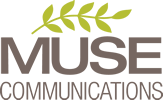Looking to Juice Your Legal Marketing? First, Take These Two Steps
If you’re an attorney who gets business from referrals (as opposed to advertising and search engine results) and you’re looking to juice your business development efforts, I recommend taking these two steps to figure out the best and smartest way to spend your limited marketing resources.
Muse Communications was named one of
Texas’ best legal public relations firms by the readers of Texas Lawyer.
Need help turning your legal marketing to-do list into reality? Just drop us a line.
Step 1: Put Yourself in Your Referral Network’s Shoes
How often are the people who send you business hearing from you? Your closest contacts — the clients and colleagues you work with regularly — probably hear from you often. That is a big reason you’re likely top of mind when they’re looking to refer business.
But those on the periphery of your contact zone — your old law school classmates, former clients, lawyers from your former firm, etc. — may only hear from you once or twice a year, if that. And that group is probably much bigger than your core list of contacts. If any of these are people who would be likely to refer you work, you’ll want to stay in touch.
As we’ve said too many times to count, personal networking is the gold standard here. But there are only so many hours in a day, and you can’t possibly break bread or have a relaxing spa day with all of the people who you should be staying in touch with.
That’s why we recommend a straightforward content marketing plan that can help stretch your networking resources. This approach works for large firms, small firms, solos, and individual lawyers, and it consists of three fundamental steps: 1) Blog posts about substantive legal topics of interest to your client base, 2) social media and 3) email, both of which are used to amplify those blog posts.
By writing something meaty even once a month and sharing it with your network via social media and email, you’re touching base with your external referral network (i.e. those people you aren’t in regular contact with). You’re also ensuring that, at the very least, they know you’re still practicing law and staying on top of developments in your practice area.
Your social media and email don’t have to be limited to amplifying your blog posts. In fact, we strongly encourage you to use your social media presence and emails to share other news, such as “best lawyer” recognitions, new lawyers at your firm, pro bono work, client successes, client testimonials, book recommendations, speaking gigs, and anything else that showcases the fact that you’re on top of your game.
Staying visible digitally (i.e. via blogging, social media, and email) isn’t just helpful for your referral network. It’s also valuable for those people who are referred to you because the first thing they’re likely to do is search for your name online.
That’s why the second step we tell people who are looking to juice their legal marketing is:
Step 2: Find Out What People See When They Search for You Online
Take a step back and pretend you’re considering hiring yourself. What do you see when you Google yourself? Is your website linking to a social media page that hasn’t been updated in two years? Is your last blog post from 2017? Does your LinkedIn profile say you’re still at the firm you left three years ago?
The first impression you make is no longer a firm handshake and a nice suit. Your online profile is your first chance to shine, so make sure it’s sending the right message. For your website bio, LinkedIn profile, and any other personal online profiles, here’s a quick checklist:
How’s your photo? Is it a recent professional portrait, or is it a selfie with your ex cropped out?
Is the narrative up-to-date, or does it still read like you’re six months out of law school?
Are your most recent presentations and articles included?
What about noteworthy representative cases?
Don’t forget about association and bar group memberships, your pro bono efforts, and other volunteer work.
For law firms, if you aren’t posting to your firm’s social media pages regularly, consider either taking them down or increasing your posting schedule. An out-of-date social media page is worse than no page at all. Ditto with your blog page. If the only thing on it is a post from 2022 that says “blog coming soon,” then take down the page until you have some content to put there.
Of course, the content marketing strategy outlined above will ensure that your blog and social media pages will never be out-of-date, so that’s another reason to put the plan to work now.
A Great Place to Start
Staying in touch with your referral network and making a spiffy online first impression aren’t the only ways to market yourself and your law firm. There are webinars, event sponsorships, advertising, podcasts, press releases, speeches, brochures, open houses, white papers, e-books, and so, so much more.
But it’s smart (and much less expensive) to pick the low-hanging fruit first: staying in front of those people who already know and like you and making a memorable first impression online.
Amy Boardman Hunt is all about helping lawyers find their voice and showcase their expertise. When she’s not doing that, she’s trying to find great hiking spots in Dallas. If you know of any – or you need a legal marketing muse – drop her a line at amy.hunt@muselegalpr.com.


